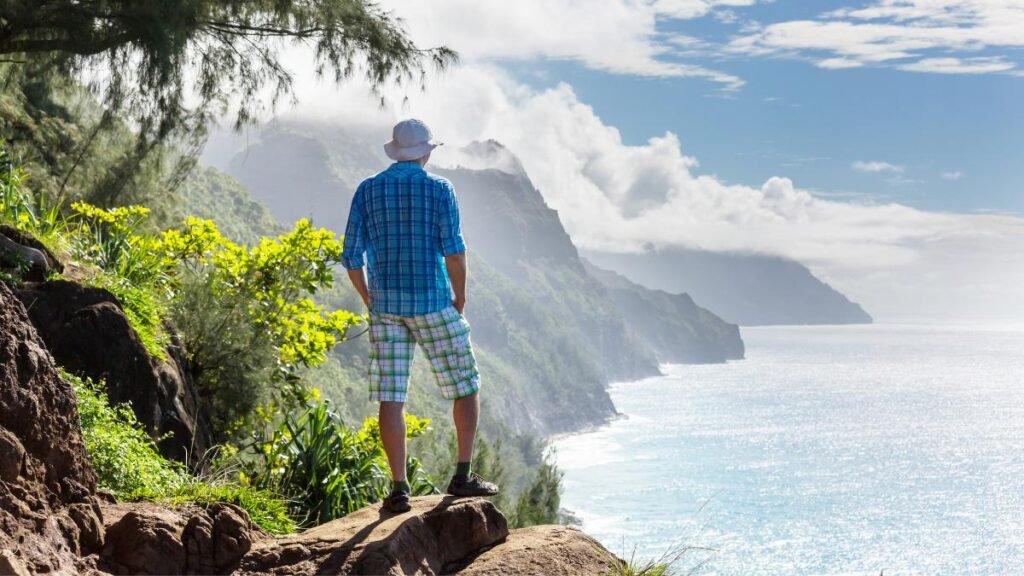Ever wondered why you see a rainbow of colors on the trail, and not just the greens and browns of nature? Well, the color of your hiking gear can actually make a significant difference. It’s not just about looking cool in your Instagram photos (although that’s a bonus!). The right color choice can enhance your safety, comfort, and overall hiking experience.
In this article, we’ll discuss the best colors to wear on your next hiking trip and those to avoid. We promise, you won’t look at your hiking wardrobe the same way again!
What is the Best Color to Wear While Hiking?

The best color to wear while hiking is neon orange, dazzling yellow, or vivid red. These colors are not common in nature, making you easily noticeable from far off distances. So, if you’re hiking during hunting season or just want to make sure other hikers can spot you, these vibrant hues are the way to go.
If you’re more into low impact and want to blend in with your surroundings, use earth tones. Colors like green, brown, tan, or black are less likely to disturb wildlife and give you a more immersive experience. But remember, safety first! If you’re going for these subdued shades, make sure you have a piece of brightly colored gear to signal for help if needed.
Pro tip: Your clothing color should depend on the context of your hike. If you’re going into a densely populated area or during hunting season, opt for those bright colors. If you’re heading into a quiet, serene trek where you’d like to blend in, choose earth tones.
Why do Hikers Wear Bright Colors?
Hikers wear bright colors for better visibility and for better group coordination.
- Visibility: When you’re out in the wilderness, you want to be seen. Not just by fellow hikers, but also by rescue teams, should an emergency arise. Bright colors stand out against the natural backdrop, making you easier to spot from a distance or from the air.
- Group Coordination: If you’re hiking with a group, wearing bright colors helps keep everyone together. You can easily spot your companions, even in dense forest or foggy conditions.
What Colors Should You Not Wear Hiking?
White and light shades are colors you should not wear while hiking. Just imagine getting all those dirt, mud, and grass stains on your pristine white shirt – definitely not a pretty sight. In addition, light colors don’t offer much protection from the sun’s UV rays, making you more susceptible to sunburns and other heat-related illnesses.
Should I Wear Black Hiking?
You might think that wearing black clothes is a good idea because it hides dirt well, but keep in mind that black absorbs heat. So, if you’re hiking in hot weather, you’ll end up feeling like a baked potato in a black outfit. What’s worse, black clothing is very difficult to spot in the dark, so it’s not a good choice for hiking during low light conditions.
But, if you’re hiking in colder weather, black could be a good choice as it absorbs heat and keeps you warmer. Just remember to layer up and wear reflective gear or add some neon accents to your outfit, so you’re still visible to others on the trail.
Is Red a Bad Color for Hiking?

Red is not a bad color for hiking. As a matter of fact, it’s actually a pretty savvy choice from a safety perspective. If you’re wearing red, you’re easy to spot – not just by your hiking companions, but also by any search and rescue teams, should you need them. It’s like wearing a beacon on your back, saying, “Here I am!”
But what about wildlife? Most animals, especially those that might pose a threat, like bears or mountain lions, are colorblind to a degree. They won’t see your red jacket and think, “Oh, there’s a juicy human!” No, they’re more likely to notice your movement and sounds. So, again, red gets a thumbs-up here.
Here are some pointers to remember:
- Point #1: Red enhances visibility, making you easier to spot in case of emergencies.
- Point #2: Most wildlife doesn’t distinguish colors like humans do. Your movement and noise matter more.
What About Blue?
Now, let’s talk about blue. Some hikers find it to be a happy medium, being bright enough to be seen yet not too flashy. It’s a solid choice if you want something different from the usual hiking palette.
However, blue blends in with the sky and can make you harder to see during certain times of the day. So, it’s not a terrible choice but might not be the best.
What is the Best Color to Wear While Hiking in Winter?

Bright colors are the best choice to wear while hiking in winter. They increase your visibility amidst the snowy landscape, making you easily noticeable to other hikers or rescue teams, if needed.
In my opinion, orange and red are standout choices. These colors contrast well against the white backdrop of snow. They can even reflect sunlight effectively, which can help retain warmth.
Avoid wearing white or camouflage colors as they can blend with the snow, making you harder to spot.
Pro Tip: When choosing your hiking attire, consider the season and environment. For example, orange might not be the best choice during hunting season, and white should be avoided in snowy conditions.
What is the Best Color to Wear in the Mountains?
Based on many hikers’ findings, bright colors are the best colors to wear in the mountains.
Colors such as neon orange, yellow, and bright red are excellent choices. They stand out against the natural backdrop of the mountains, making you easily noticeable to other hikers or hunters.
Pro tip: If you’re hiking with your furry friend, it’s a good idea to have them wear a blaze orange vest. It’s a great way to ensure your pet’s safety as well.
Conclusion
When choosing what clothes to wear while hiking, remember that safety comes first. Make yourself visible and easily recognizable to others on the trail. If you want to blend in with nature, choose earth tones.
Avoid white and light colors that can get dirty easily and offer little protection from the sun. And, while black may hide dirt well, it’s not a good choice for hot weather or low light conditions.
Overall, choose bright colors like neon orange, dazzling yellow, or vivid red to stand out on the trail – you never know when it might come in handy.





